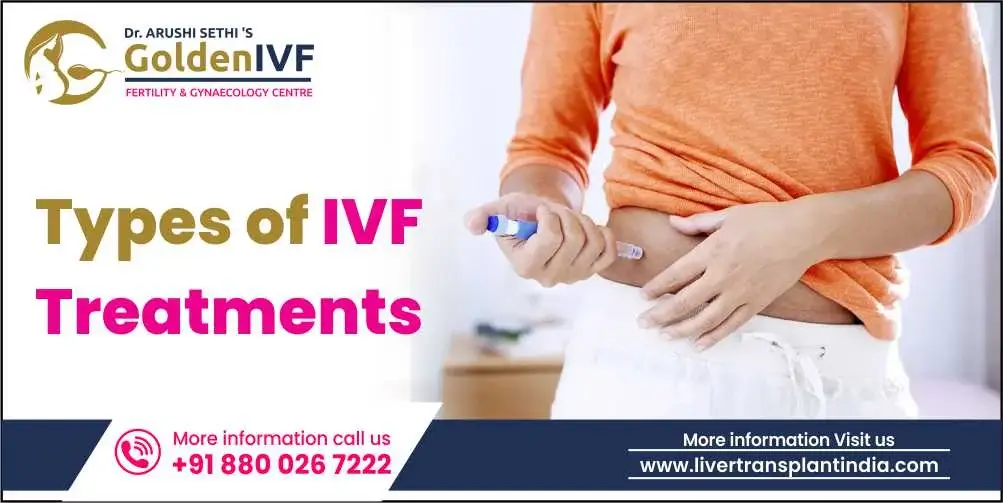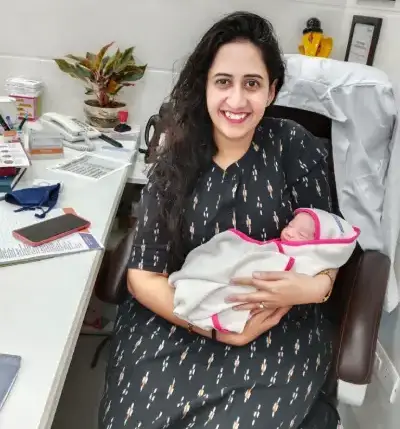In vitro fertilization (IVF) is one of the most widely used fertility treatments to help couples conceive. Over the years, IVF has evolved with different techniques to suit various medical conditions. Choosing the right type of IVF treatment depends on factors like age, egg and sperm quality, previous pregnancy history, and underlying health conditions.
At Dr. Arushi Sethi’s Golden IVF Centre, a range of IVF treatments are offered to ensure the best chance of success. Understanding these options can help couples go for the most suitable treatment method. Here’s a look at different types of IVF treatments and who they are meant for.
Standard IVF (Conventional IVF)
Conventional IVF is the standard method, where the woman takes hormonal injections to stimulate the ovaries to produce multiple eggs. Once mature, these eggs are retrieved and fertilized with sperm in a lab. The resulting embryos are monitored, and the best ones are transferred into the uterus.
Who should consider it?
- Women with normal ovarian reserve.
- Couples with unexplained infertility, endometriosis, and blocked fallopian tubes.
- Male factor infertility cases where sperm quality is slightly compromised.
- Women who have not conceived through simpler treatments like ovulation induction or IUI.
Things to consider:
- Requires multiple injections for ovarian stimulation.
- Produces more eggs, increasing chances of success.
- Higher chances of multiple pregnancies if more than one embryo is transferred.
- It can be physically demanding and requires regular monitoring (blood tests, ultrasounds) throughout the treatment cycle.
Mild Stimulation IVF (Mini IVF)
Mild stimulation IVF is similar to conventional IVF but uses lower doses of medications to stimulate the ovaries. It aims to retrieve fewer, but good-quality eggs.
Who should consider it?
- Women who do not want excessive hormonal injections.
- Those at risk of ovarian hyperstimulation syndrome (OHSS).
- Women with low ovarian reserve who may not respond well to high-dose stimulation.
Things to consider:
- Lower medication use means fewer side effects.
- Fewer eggs retrieved compared to conventional IVF.
- Might require more IVF cycles to achieve pregnancy.
Natural Cycle IVF
Natural cycle IVF does not involve hormonal stimulation. The process follows the woman’s natural ovulation cycle, retrieving the single egg produced in that cycle. The egg is fertilized in the lab, and the resulting embryo is transferred into the uterus.
Who should consider it?
- Women with very low ovarian reserve and who naturally produce only one egg per cycle.
- Those who cannot or do not want hormone stimulation.
- Women with medical conditions that make hormone therapy unsuitable.
- Women who have had poor responses to conventional IVF but still want to attempt pregnancy with their own eggs.
Things to consider:
- Less stressful as there are no hormone injections.
- Only one egg is retrieved, reducing the chances of success.
- Multiple cycles may be needed to achieve pregnancy.
IVF with Intracytoplasmic Sperm Injection (ICSI)
ICSI is an advanced technique used in IVF where a single sperm is directly injected into an egg. This is mainly used for cases with male infertility issues.
Who should consider it?
- Men with low sperm count or poor motility.
- Men with sperm morphology issues (abnormal sperm shape).
- Cases where previous IVF cycles had poor fertilization.
- Couples with unexplained infertility.
- Cases where the sperm cannot penetrate the egg naturally.
- Couples using sperm from a donor where sperm quality is in question.
Things to consider:
- Requires specialized equipment and expertise, making it more expensive than traditional IVF.
- Does not improve embryo quality; it only ensures fertilization.
- There’s an increased risk of genetic defects when ICSI is used in cases of male infertility.
IMSI (Intracytoplasmic Morphologically Selected Sperm Injection)
IMSI is a more advanced form of ICSI (Intracytoplasmic Sperm Injection), where sperm selection is based on its morphology (shape). This method uses a high-powered microscope to examine sperm in greater detail, selecting the healthiest sperm to inject into the egg.
Who should consider it?
- Men with high levels of abnormal sperm.
- Couples with repeated IVF or ICSI failures.
Things to consider:
- Increases chances of choosing genetically healthy sperm.
- More expensive than ICSI due to the use of advanced microscopy technology.
- It requires specialized equipment and highly skilled embryologists, so not all fertility clinics may offer this treatment.
Frozen Embryo Transfer (FET)
FET involves using embryos that were previously frozen in an earlier IVF cycle. These embryos are thawed and transferred into the uterus during a later cycle without ovarian stimulation.
Who should consider it?
- Women who had extra embryos from a previous IVF cycle.
- Couples who want to preserve embryos for future pregnancies.
- Women who experienced complications in a fresh embryo transfer cycle.
Things to consider:
- Higher success rates since embryos are transferred in a more naturally prepared uterine environment.
- Allows for better timing of embryo transfer.
IVF with Donor Eggs
In some cases, a woman’s eggs may not be suitable for conception. In such situations, donor eggs can be used. The donor eggs are fertilized with the partner’s sperm, and the embryo is transferred to the woman’s uterus.
Who should consider it?
- Women with premature ovarian failure.
- Women with poor egg quality and early menopause.
- Women who are over 40 years old.
- Cases where previous IVF cycles have failed due to egg-related issues.
Things to consider:
- Involves using eggs from a healthy, screened donor.
- The cost can be significantly higher due to the use of donor eggs.
- Emotional and psychological implications may arise when the baby is not genetically related to the mother.
- The legal aspects of egg donation should be carefully considered, as donor anonymity, rights, and future parental obligations may need to be addressed.
- While egg donation IVF involves the use of another woman’s eggs, the recipient mother still has the opportunity to carry and deliver the child.
IVF with Donor Sperm
Donor sperm is used when the male partner has no sperm, poor sperm quality, or carries genetic disorders. The donor sperm is used to fertilize the eggs in the lab.
Who should consider it?
- Men with no sperm production (azoospermia).
- Couples where the male has a genetic condition that could pass to the child.
- Single women or same-sex couples.
Things to consider:
- Selection of a suitable sperm donor.
- The cost of sperm donation IVF can vary, especially if you need to use a sperm bank.
- Legal issues regarding the use of donor sperm should be thoroughly addressed, especially in the case of known donors.
- The emotional aspects of raising a child with a donor’s genetic material may need careful consideration.
Preimplantation Genetic Testing (PGT) with IVF
PGT involves testing embryos for genetic conditions before implantation. It ensures that only healthy embryos are transferred.
Who should consider it?
- Couples with a history of genetic conditions such as thalassemia or cystic fibrosis.
- Women experiencing recurrent miscarriages.
- Older women at risk of chromosomal abnormalities in embryos.
- Couples with repeated IVF failures.
Things to consider:
- Additional cost.
- Helps in selecting the best embryo.
- The genetic testing process involves risks to the embryos, though these are typically minimal.
In Vitro Maturation (IVM)
In Vitro Maturation (IVM) is an alternative to traditional IVF, where eggs are retrieved from the ovaries before they are fully matured. Instead of using hormonal stimulation to mature the eggs in the body, the eggs are matured in the laboratory setting.
Who should consider it?
- Women with polycystic ovary syndrome (PCOS), who are at risk of ovarian hyperstimulation.
- Those who want to avoid excessive hormonal injections.
- Women with a history of OHSS or poor response to standard IVF stimulation.
Things to consider:
- Less medication is required.
- The success rate of IVM may be lower than that of traditional IVF, as it is a newer technique and is still under research for various patient groups.
IVF with Surrogacy (Gestational Carrier)
IVF with surrogacy involves a surrogate mother carrying a pregnancy for another individual or couple. The surrogate has no genetic relationship to the child as the embryo is created via IVF using the intended mother’s egg or a donor egg and the intended father’s sperm or donor sperm.
Who should consider it?
- Women with medical conditions that prevent carrying a pregnancy.
- Those who have had multiple pregnancy losses.
Things to consider:
- Choosing a reputable agency and ensuring the surrogate’s rights are properly addressed is crucial.
- Emotional aspects are involved.
- Legal contracts and thorough screening are essential in surrogacy arrangements to ensure the well-being of both the surrogate and the child.
- The process can be expensive, especially with legal fees, surrogacy compensation, and medical costs.
Conclusion
IVF treatments are not the same for everyone. Each type of IVF is designed to address different medical needs and conditions. Whether it is conventional IVF, donor-assisted treatments, or advanced genetic testing, choosing the right method can improve success rates and lead to a healthy pregnancy.
If you are considering IVF, it is important to consult an experienced fertility specialist. At Dr. Arushi Sethi’s Golden IVF Centre, we provide expert guidance and customized treatment plans based on individual medical history and needs. Our team is dedicated to helping couples achieve their dream of parenthood with the latest advancements in fertility treatment. Book a consultation today to explore the best IVF options for you.


